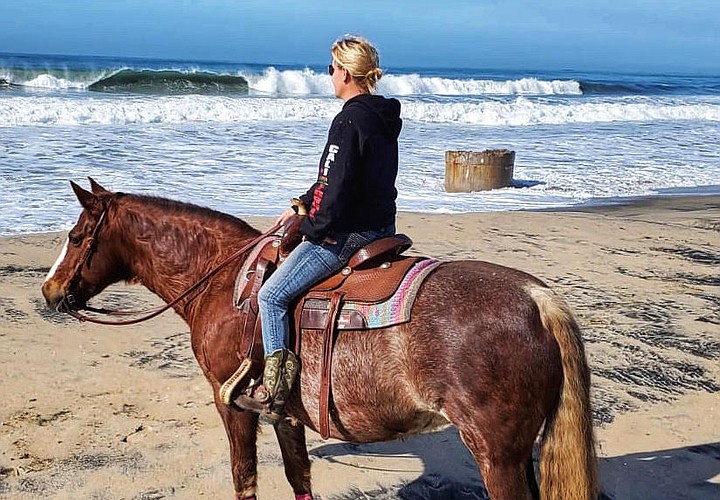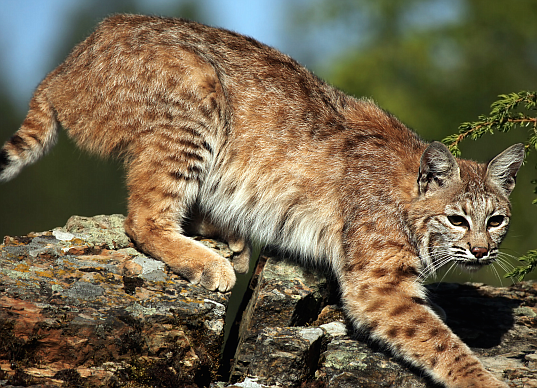 Facebook
Facebook
 X
X
 Instagram
Instagram
 TikTok
TikTok
 Youtube
Youtube

In the last two weeks, some Imperial Beach inhabitants warned their neighbors of bobcats lurking in their southwesternmost city of the United States.
"I was not surprised, as I have seen bobcats in the river valley," equestrian Andrea Lehnert said to me on April 25. "Last year, we encountered one bobcat in front of us on the horse trail; we followed it, hoping we could get a closer look, but it disappeared into the bushes. I'll send you pictures."

Shirley Nakawatase took to Facebook to warn her IB neighbors. "[There are] bobcat sighting in the sloughs, south of [the] sports park; keep small animals and pets protected."
Nakawatase, an accountant by trade, has lived next to the Tijuana Slough National Wildlife Refuge since 1971.
"There's a lot of rabbits just south of the softball field off of 5th Street and Imperial Beach Boulevard," Nakawatase direct messaged me on April 25. "Coyotes and now bobcats come in there to feed regularly."

Lehnert's and Nakawatase's IB neighbors are confused about what a bobcat is.
"Bobcats are only one quarter to less than one half the size of a mountain lion," says the California Department of Fish and Wildlife government site. "[And] bobcats are generally two or three times as large as a domestic house cat and more muscular and full in the body. The bobcat's tail is 'bobbed' in appearance (4-6 inches) and much shorter than the tail of a mountain lion and most domestic cats."
Underneath Nakawatase's online warning to her IB neighborhood pet owners, three locals had opposing views of the native-California bobcats that can weigh up to 21 lbs. and measure up to three feet in length.

"And kids!" exclaimed one neighbor; "Bobcats aren't known for attacking humans at all," opined the second resident; "Uhm, I still wouldn't take the risk with my children, would you?" interjected the third neighbor.
".... Bobcats are super [skittish], so yes," responded the second resident. "I'm not going to freak out and not let my young daughter play. They look like house cats. They're not mountain lions."
The government agency's site states that "Bobcats are by nature wary of people and may not pose a significant threat to human safety. However, unprotected pets and livestock may be at risk. If you live near or where bobcats and other wildlife live, prevention is key in reducing human-wildlife conflict and preventing the loss of pets and livestock."
The government agency's reference site further advises us to make sure we secure our pets and livestock, hide all potential sources of food, and never feed wildlife, which includes bobcats. It further distinguishes bobcats by their "round" faces with "longer fur on the side of their head giving the appearance of sideburns" and the "backs of the [pointed] ears that are black."
"All these little communities across the Southwest are nestled up against water sources because they needed those springs or creeks. Well, the same is true of the wildlife; they need the water," said Dan Millis of the Sierra Club in a www.DesertSun.com article published in 2019. "Millis [added that] wildlife along many stretches of the existing 650-mile border wall from San Diego to the Rio Grande have suffered due to habitat fragmentation, loss of food and other impacts."
While the article focuses on endangered species transversing between our borders, it mentions bobcats in the Jacumba area about 75 miles east of the Tijuana River Valley Regional Park, where Lehnert boards her horse.
"Around summertime last year, I was riding my horse by Hollister Street in the evening," she recounted, "and a bobcat jumped in front of us, looked at my horse, and ran away."
Lehnert, 39, frequently rides her horse, Souri Caraguata, along the trails near the border wall towards our beach by Border Field State Park, which butts up against Playas de Tijuana.
"I am wondering if, at the border, are the bobcats able to cross freely?" I asked Lehnert. "No, because of the fences," she responded. "At least the parts I know that are fenced up. I believe their natural habitat is the river valley; they can hide there, and there are many food choices. I did hear from others riding in the valley their whole lives is that bobcats have always been there."
Lehnert isn't too concerned about the border wall affecting the diverse wildlife, but more so "the sewage problem within Mexico. The valley and its wildlife are extraordinary, and there needs to be a solution to the pollution problem. If the wildlife drink from this river, they can [possibly] die immediately."
Bobcats "are found throughout most of California," states the wildlife agency, "yet typically go unseen due to their quiet and solitary ways. However, bobcat sightings are increasing as they appear to be using urban and suburban settings more often."


In the last two weeks, some Imperial Beach inhabitants warned their neighbors of bobcats lurking in their southwesternmost city of the United States.
"I was not surprised, as I have seen bobcats in the river valley," equestrian Andrea Lehnert said to me on April 25. "Last year, we encountered one bobcat in front of us on the horse trail; we followed it, hoping we could get a closer look, but it disappeared into the bushes. I'll send you pictures."

Shirley Nakawatase took to Facebook to warn her IB neighbors. "[There are] bobcat sighting in the sloughs, south of [the] sports park; keep small animals and pets protected."
Nakawatase, an accountant by trade, has lived next to the Tijuana Slough National Wildlife Refuge since 1971.
"There's a lot of rabbits just south of the softball field off of 5th Street and Imperial Beach Boulevard," Nakawatase direct messaged me on April 25. "Coyotes and now bobcats come in there to feed regularly."

Lehnert's and Nakawatase's IB neighbors are confused about what a bobcat is.
"Bobcats are only one quarter to less than one half the size of a mountain lion," says the California Department of Fish and Wildlife government site. "[And] bobcats are generally two or three times as large as a domestic house cat and more muscular and full in the body. The bobcat's tail is 'bobbed' in appearance (4-6 inches) and much shorter than the tail of a mountain lion and most domestic cats."
Underneath Nakawatase's online warning to her IB neighborhood pet owners, three locals had opposing views of the native-California bobcats that can weigh up to 21 lbs. and measure up to three feet in length.

"And kids!" exclaimed one neighbor; "Bobcats aren't known for attacking humans at all," opined the second resident; "Uhm, I still wouldn't take the risk with my children, would you?" interjected the third neighbor.
".... Bobcats are super [skittish], so yes," responded the second resident. "I'm not going to freak out and not let my young daughter play. They look like house cats. They're not mountain lions."
The government agency's site states that "Bobcats are by nature wary of people and may not pose a significant threat to human safety. However, unprotected pets and livestock may be at risk. If you live near or where bobcats and other wildlife live, prevention is key in reducing human-wildlife conflict and preventing the loss of pets and livestock."
The government agency's reference site further advises us to make sure we secure our pets and livestock, hide all potential sources of food, and never feed wildlife, which includes bobcats. It further distinguishes bobcats by their "round" faces with "longer fur on the side of their head giving the appearance of sideburns" and the "backs of the [pointed] ears that are black."
"All these little communities across the Southwest are nestled up against water sources because they needed those springs or creeks. Well, the same is true of the wildlife; they need the water," said Dan Millis of the Sierra Club in a www.DesertSun.com article published in 2019. "Millis [added that] wildlife along many stretches of the existing 650-mile border wall from San Diego to the Rio Grande have suffered due to habitat fragmentation, loss of food and other impacts."
While the article focuses on endangered species transversing between our borders, it mentions bobcats in the Jacumba area about 75 miles east of the Tijuana River Valley Regional Park, where Lehnert boards her horse.
"Around summertime last year, I was riding my horse by Hollister Street in the evening," she recounted, "and a bobcat jumped in front of us, looked at my horse, and ran away."
Lehnert, 39, frequently rides her horse, Souri Caraguata, along the trails near the border wall towards our beach by Border Field State Park, which butts up against Playas de Tijuana.
"I am wondering if, at the border, are the bobcats able to cross freely?" I asked Lehnert. "No, because of the fences," she responded. "At least the parts I know that are fenced up. I believe their natural habitat is the river valley; they can hide there, and there are many food choices. I did hear from others riding in the valley their whole lives is that bobcats have always been there."
Lehnert isn't too concerned about the border wall affecting the diverse wildlife, but more so "the sewage problem within Mexico. The valley and its wildlife are extraordinary, and there needs to be a solution to the pollution problem. If the wildlife drink from this river, they can [possibly] die immediately."
Bobcats "are found throughout most of California," states the wildlife agency, "yet typically go unseen due to their quiet and solitary ways. However, bobcat sightings are increasing as they appear to be using urban and suburban settings more often."
Comments